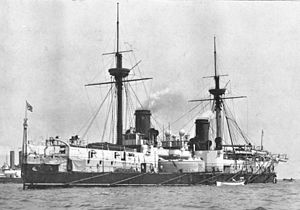HMS Inflexible (1881)

HMS Inflexible with the pole masts fitted in 1885, replacing the original full sailing rig
|
|
| Class overview | |
|---|---|
| Succeeded by: | Ajax class |
| History | |
|
|
|
| Builder: | Portsmouth Dockyard |
| Cost: | £812,000 |
| Laid down: | 24 February 1874 |
| Launched: | 27 April 1876 |
| Commissioned: | 5 July 1881 |
| Fate: | Scrapped 1903 |
| General characteristics | |
| Displacement: |
|
| Length: |
|
| Beam: | 75 ft (23 m) |
| Draught: | 26.3 ft (8.0 m) |
| Propulsion: | 12 coal-fired boilers, two single-expansion Elder and Co. steam engines, 2 twin-bladed 20 ft (6.1 m) diameter screws |
| Speed: | 14.73 knots (27 km/h) @ 6,500 hp (4.8 MW) |
| Range: | "Cross-Atlantic at economical speed" |
| Complement: | 440–470 |
| Armament: |
|
| Armour: |
|
HMS Inflexible was a Victorian ironclad battleship carrying her main armament in centrally placed turrets. The ship was constructed in the 1870s for the Royal Navy to oppose the perceived growing threat from the Italian Regia Marina in the Mediterranean.
The Italian Navy had started constructing a pair of battleships, Duilio and Dandolo, equipped with four Armstrong 17.7-inch (450 mm) guns weighing 100 tons each. These were superior to the armament of any ship in the British Mediterranean Squadron, and Inflexible was designed as a counter to them.
Inflexible mounted larger guns than those of any previous British warship and had the thickest armour ever to be fitted to a Royal Navy ship. Controversially, she was designed so that if her un-armoured ends should be seriously damaged in action and become water-logged, the buoyancy of the armoured centre section of the ship would keep her afloat and upright.
The ship was the first major warship to depend in part for the protection of her buoyancy on a horizontal armoured deck below the water-line rather than armoured sides along the waterline.
The original concept was based upon an outline design similar to that for HMS Dreadnought, but with improved armament. The ship was conceptually constructed from three components, several outline studies being produced by Nathaniel Barnaby.
A heavily armoured citadel 75 feet (23 m) wide and 110 feet (34 m) long was located amidships, which would keep the ship afloat and stable regardless of what happened to the ends. This citadel contained the main guns, the boilers and the engines. The ends were unarmoured, but with a 3-inch-thick (76 mm) armoured deck 6–8 ft below the waterline to limit damage to the underwater section to keep them buoyant. Coal bunkers were located over the armoured deck and surrounded by 4-foot-wide (1.2 m) compartments filled with cork. The ship had bunker capacity for 400 tons of coal below the deck for use during combat, when the above-deck bunkers would be inaccessible and possibly flooded. The structure above the armoured deck also contained a large number of watertight compartments to further preserve buoyancy. There was also light superstructure to provide crew accommodation, and freeboard in rough weather, although anticipated to be seriously damaged in any major engagement.
...
Wikipedia
